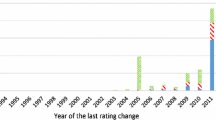Abstract
The concept of credit rating rooted back to mid-nineteenth century has become one of the most important elements in the world economy together with the globalization period gradually accelerating in the last two decades and increasing the interaction and sensitivity in the international markets. With the globalization and deepening in the financial markets; the effect, reliability and stability of knowledge of the actors who are in charge for directing the global capital flows have quite a big importance in terms of the decisions to be made in the future. In this process, credit rating agencies eliminating the information asymmetry between the countries and institutions who want to create financial resource by borrowing from the savings owners and foreign institutions. Credit ratings determined by the mentioned organizations are accepted as an indicator of the countries to meet the financial obligations in other words their creditworthiness. For Turkey’s economy having a structure with a high level of external financing needs in terms of accelerating the growth and development process, it is inevitable to have an international creditworthiness increasing long-term investment tendency meeting foreign capitals’ trust search. In this study, firstly the determinants of the credit ratings given by credit rating agencies are determined and then forecasting Turkey’s future credit ratings by combining them with multivariate grey model and grey relational analysis are performed.









Similar content being viewed by others
Notes
GDP:Gross Domestic Product
References
Afonso, A. 2002. Understanding the determinants of government debt ratings: evidence for the two leading agencies. Department of Economics and Research Center on the Portuguese Economy (CISEP) Working paper, 2002/2.
Afonso, A., P.M. Gomes, and P. Rother. 2009. Ordered response models for sovereign debt ratings. Applied Economic Letters 16:769–773.
Alexe, S., P.L. Hammer, A. Kogan, and M.A. Lejeune. 2003. A non-recursive regression model for country risk rating. Report: RUTCOR—Rutgers University Research. 9.
Balıkçıoğlu, E. 2013. Ülkelerin finansal açıdan kredi notlarını etkileyen faktörler ve kurallı maliye politikasının etkisi: 2000 sonrası dönem Türkiye’de uygulanan maliye politikalarının kredi notları üzerindeki etkisinin karşılaştırmalı analizi. Doctoral Thesis, Ankara University Institute of Social Sciences.
Bozic, V., and C. Magazzino. 2013. Credit rating agencies: the importance of fundamentals in the assessment of sovereign ratings. Economic Analysis & Policy 43(2): 157–176.
Cantor, R., and F. Packer. 1996. Determinants and impact of sovereign credit ratings. Economic Policy Review 2(2): 37–54.
Ferri, G., L. Lui, J. Gang, and E. Stiglitz. 1999. Are credit ratings pro-cyclical? Evidence from east Asian countries. Economic Notes 28(3): 335–355.
Fitch Ratings (2012) Fitch ratings sovereign rating criteria. https://www.fitchratings.com/site/criteria/pfsov.html. Accessed 4 January 2016.
Gür, T.H. 2001. A country risk assessment model and the Asian crisis. Central Bank Review 1: 49–68.
Hammer, P.L., A. Kogan, and M.A. Lejeune. 2006. Modeling country risk ratings using partial orders. European Journal of Operational Research 175: 836–859.
Haspolat, F.B. 2015. Ülke kredi notlarının belirleyicileri: Türkiye’nin kredi notunun ülke karşılaştırmalı analizi. Dissertation, Republic of Turkey Ministry of Development.
IMF. Financial indicators database. http://elibrary-data.imf.org/FindDataReports.aspx?d=33061&e=169393. Accessed 20 February 2016.
Kalliomäki, M. 2012. Determinants of sovereign defaults: an examination of fundamental factors derived from credit ratings. Master Essay: Institution of Economics University of Lund.
Lee, S.H. 1993. Are the credit ratings assigned by bankers based on the willingness of the LDC borrowers to repay?. Journal of Development Economics 40.
Lin, C.S., F.M. Liou, and C.P. Huang. 2011. Grey forecasting model for CO2 emissions: a Taiwan study. Applied Energy 88: 3816–3820.
Moody’s (2015) Rating methodology; sovereign bond ratings. https://www.moodys.com/research/Moodys-publishes-sovereign-rating-methodology--PR_282238. Accessed 6 January 2016.
Mora, N. 2006. Sovereign credit ratings: guilty beyond reasonable doubt? Journal of Banking and Finance 30: 2041–2062.
Reinhart, C. 2002. Default, currency, crises and sovereign credit ratings. NBER Working Paper Series 8738.
Rowland, P., and J.L. Torres. 2004. Determinants of spread, credit ratings and creditworthiness for emerging market sovereign debt: a panel study. Banco de la Republica.
S&P (2014) Rating definitions. Capital IQ Mc Graw Hill financial global credit portal. http://www.standartpoors.com/ratings/definitions-and-faqs/en/us. Accessed 15 January 2016.
Sutton, G. 2005. Potentially endogenous borrowing and developing country sovereign credit ratings, 5. Bank for Settlements: Financial Stability Institue Occasional Paper.
Teker, D., A. Pala, and O. Kent. 2013. Determination of sovereign rating: factor based ordered probit models for panel data analysis modelling framework. International Journal of Economics and Financial Issues 3(1):122–132
The World Bank. Worldwide governance indicators. http://data.worldbank.org/data-catalog/world-development-indicators. Accessed 15 January 2016.
Author information
Authors and Affiliations
Corresponding author
Rights and permissions
About this article
Cite this article
Karaaslan, A., Özden, K.Ö. Forecasting Turkey’s Credit Ratings with Multivariate Grey Model and Grey Relational Analysis. J. Quant. Econ. 15, 583–610 (2017). https://doi.org/10.1007/s40953-016-0064-1
Published:
Issue Date:
DOI: https://doi.org/10.1007/s40953-016-0064-1




